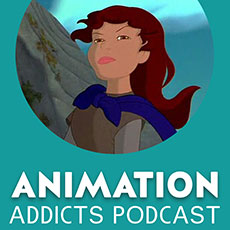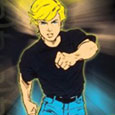Warner Bros Theatrical Animation (May 15 1998), Warner Home Video (October 20 1998), single disc, 86 mins plus supplements, 1.78:1 anamorphic widescreen, Dolby Digital 5.1 Surround, Rated G, Retail: $19.98
Storyboard:
Set in Medieval times, King Arthur’s (Pierce Brosnan) mythical sword Excalibur is stolen by the twisted knight Sir Ruber (Gary Oldman) to use for his takeover bid on Camelot. Excalibur is lost somewhere in the Forbidden Forest, so Ruber creates a quasi-mechanical army using his men to storm Camelot. Meanwhile Kayley (Jessalyn Gilsig), the daughter of one of Arthur’s knights who met his death years before, still dreams of the day when she could take her father’s place at the round table. When she hears of Ruber’s plan, and the lost sword, she sets off to find it and help in King Arthur’s battle to save Camelot. Along the way Kayley meets Garrett (Cary Elwes), a blind man who wants for nothing and lives alone in the Forbidden Forest. He knows every leaf and deadly area in the forest, and reluctantly helps Kayley across the forest in the search for Excalibur. They soon find themselves in danger from Ruber’s men, but with a little help from a two-headed dragon named Devon and Cornwall (Eric Idle and Don Rickles) eventually make it to Camelot. There, they must team up with Arthur and his knights to stop Ruber and regain Excalibur once and for all…
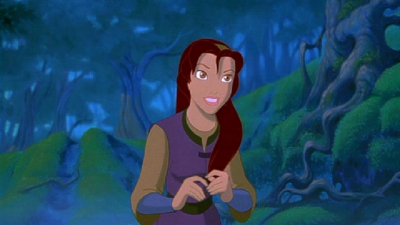
The Sweatbox Review:
Following the success of Disney’s The Lion King (not only the second biggest film ever at the time, but the most successful animated feature in history), the major studios all took another look at dipping into the animation pool. Fox announced its first project and DreamWorks was being formed, but at that time no one was is a better position than Warner Bros. to make a grab for Mickey’s crown. One of the most successful animation companies to rival Disney, the Studio had given us Bugs, Daffy, Tweety and Sylvester, and the Tazmanian Devil. Not only did they have a rich history and great characters, but a fully operational animation division already in place, which at this point was turning out TV fare such as Tiny Toons Adventures and Animaniacs.
The Studio had also already released some Bugs and Daffy features, which were little more than compilations from their cartoon shorts library. The likes of The Looney Looney Looney Bugs Bunny Movie, The Bugs Bunny/Road Runner Movie, 1001 Rabbit Tales and Daffy Duck’s Fantastic Island were not only successful (especially on home video) and cheap to churn out, but also kept these classic characters in the public eye. It was natural that WB would want to tap into that mine of established recognition, and so their first offering in feature animation was the live-action combo Space Jam, in 1996, which had a good third of its animation completed at Warners’ UK Studio in London.
Flash forward one year later, and theatrical animation was becoming crowded and more serious in tone. Disney’s Hunchback and Fox’s Anastasia had shown that there was an audience for these darker, more adult stories, and DreamWorks’ upcoming Antz and The Prince Of Egypt were being marketed as major events to rival Disney’s own, with marketing stressing that these were not just more run-of-the-mill toon movies. Warners’ rather knee-jerk response was to put The Quest For Camelot into production.
During the making of a film, ideas and concepts obviously come and go. Some stay (or cling on!) and some (usually the more risky suggestions) never make it to the screen. Back in 1986/87, I was able to visit the London WB Studio, where storyboards and concept art lined the walls. At that time, the film was a much more ambitious effort than was eventually released, and reminded me a great deal of the look and tone of The Black Cauldron. I was excited by the prospect of what Quest For Camelot could be, especially as it was taking a huge leap of faith for a mainstream Studio picture by having its male lead portrayed as a blind man. And the story, as told by the manager of the Studio, sounded riveting and different.
This original take on the story would have been an interesting variation on the Arthurian legend. As it was, in an attempt to out-Mouse Disney, more songs were added, the comedy was played up, and the film slowly became diluted. There are some scenes that just don’t make sense, or a bit of comic business that doesn’t fit in and really shouldn’t be there. Some of the minor characters are suddenly awarded full scenes for themselves, while the main characters are poorly sketched with regards to character exposition. Kayley herself is outlined in a prologue that sets up the action, but Ruber just appears and states his plans against Arthur in a matter of seconds. There is no real emotional journey these characters travel or why they behave the way they do; everything just seems to happen with no real reason. Likewise, King Arthur himself is barely given a noble entrance. First seen in a wide shot, he’s too busy singing and wandering through his castle to really show his face in close up and make an impact. Okay, so this story isn’t really about Arthur, but he is the King, and his legendary sword the reason all this is happening, and he’s just a supporting player, much like Merlin (Sir John Gielgud) who just seems to stand around with not much to do!
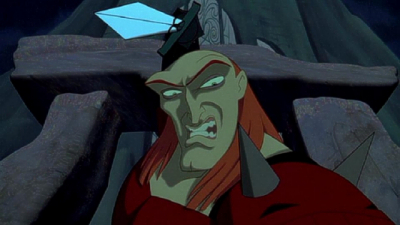
If it’s not obvious yet, it’s in the direction overall that The Quest For Camelot falls short. The film just doesn’t seem big or epic enough. Director Frederik Du Chau was a travelling artist, never really settling at one company. He’d contributed to various animated commercials and TV shows before landing a job at Disney Animation France. He produced his own short soon after which took him to the US when it was slated to appear at the Animation Celebration. He worked in the States for a couple of years, directing animation for The Land Before Time 3, and ending up at Chuck Jones Productions, where he was put forward as a promising director during the building of Warners’ feature animation division.
Many were surprised at the choice, as his independent short was apparently a very “art-house” affair. Perhaps this is what Warners were looking for, but on the other hand there was a lot of time and money and the name of Warner Animation on the line, and the Studio weren’t about to take too many chances! I think this is why the film ended up being such a clash of ideas, characters and tone. The styling on Quest For Camelot is visually very detailed and interesting, and some the backgrounds are as good as anything in classic Disney. The main character animation, however, is most certainly not in that class.
Things start off quite well; there’s some nice interplay between young Kayley and her father that is handled sweetly. The opening song kicks in and for a moment you are transported into the world of knights and magic. The CG-enhanced animation blends well (Warner Animation would perfect this in their next film The Iron Giant, under a much more precise director), and everything seems to be going so smoothly…until the story begins proper. As mentioned previously, Ruber seems to fly off the handle for the smallest reason, and despite the dialog exposition, it just doesn’t ring true. Kayley, who could have been the animated Sigourney Weaver as far as being the female who takes on all comers with the energy and passion of the most powerful man, just becomes a sidekick to Garrett after his introduction. Then they both become sidekicks to Devon and Cornwall who, while an inspired creation that seems to have wandered in from a better film, is in danger of overpowering this one!
The animation veers from being top-drawer, to being very poorly realized. There are moments (mainly in young Kayley’s expressions) when things are great, but otherwise this is only slightly better than TV quality dressed up for the big screen. Some of the perspective is out, such as when Arthur is praising Kayley’s father (just look at the size of those hands!) and at other times, some neat ideas are not carried through. One instance is Kayley’s transformation from young girl to young woman in the water reflection, which would have been great as a shimmering morph. Instead, the ripples of the water break up her features until the water settles back and her older face is revealed. Conversely, Ruber’s final scene is quite daring and his comeuppance the kind of thing that would have really pushed The Black Cauldron over the edge!
On the other hand, King Arthur has been completely muddled, while the horses – notoriously tough to make work in animation – are ham fisted and do not impress in any way. None of the animation is particularly up there with the recent efforts from Disney and DreamWorks, and although the animators may be more than adept at drawing Bugs and the gang, they simply may have taken on a little too much here. Not for lack of trying, but the timing and acting of the humans isn’t quite there, with characters lurching into jumpy staccato movements within a matter of frames. To put it another way, and I’m not sure that this makes much sense, it’s as if they were trying to animate more than the requisite 24 frames of animation needed per second even though it’s been animated on twos.
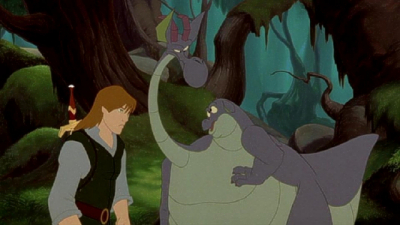
Certainly the best thing in the film is the two-headed dragon (“we’re the reason cousins shouldn’t marry”). As with the Genie in Aladdin, both the design and voices combine perfectly to create a new living entity, and unsurprisingly much of the film’s marketing was centered around this breakout character(s). The joke is that one head doesn’t see eye to eye with the other, and one of the high points of the entire film comes mid-way, with each head bemoaning the fact that they’re tied, whatever they do. Of course, by the film’s end Devon and Cornwall find that two heads are better than one and despite a chance for separation, they decide to literally stick together. Their song If I Didn’t Have You does give us an opportunity to have some fun during the garbled and often tedious plot, and there are some nice comical moments that, although wildly out of place, are a breath of fresh air!
The other songs throughout the film, written by David Foster and Carol Bayer Sager (the wife of one of the Warner execs – wonder how she got the job?), are actually quite good, the best being Kayley’s On My Father’s Wings. The story behind Garrett’s I Stand Alone is a little too close to the Pocahontas song Colors Of The Wind, while Ruber’s dastardly plan-as-a-musical moment comes across as being a tired and testing, as opposed to tried and tested, way to get information across. The soundtrack brought in a lot of talent and the songs within the film are performed by the likes of The Coors, Bryan White and Celine Dion. Steve Perry recorded another chart version of I Stand Alone, while LeAnn Rimes released the ballad Looking Through Your Eyes. The most unexpected success came with the Dion track, which was Oscar nominated, and has since been performed and re-recorded by a number of different artists.
Released in the UK as The Magic Sword, Quest For Camelot failed to set the box-office alight on either side of the Atlantic. One of my bugbears in the way the film was promoted was in its disregard for the sword itself. A number of poster images, all showing the main leads standing before Camelot, had the sword seemingly no-where to be found. On closer inspection, and depending on the key art, you’d find the sword either lying at Kayley’s feet or propped up on the side by a stone, but surely this should have been brandished by the characters in a bold fashion? And shouldn’t the film have actually been called “Quest For Excalibur”? Look at any Disney sleeve featuring a sword – it’s a major part of the artwork. Here, the sword IS the story, and it’s regulated to minor “prop”.
That’s the general feeling that comes from this particular quest for Camelot; that some obscurities have been given much time and attention, while leaving the important details left wanting. Hardly a classic, Quest For Camelot is probably best looked at by animation fans as the film that served as the Warner Feature Animation artists’ training ground, on their way to creating their masterpiece The Iron Giant, with Brad Bird’s direction. None of this will matter to kids, who will probably enjoy the colorful adventure anyway, although some may question the reasoning behind some moments – even kids aren’t easily that fooled! With cheap and easy references to pop-culture and other films (an audacious poke at The Lion King only reminds that Quest is no-where in that league and a Superman theme reprise seems thrown in), there’s also just about enough to keep adults from dozing off. It would have been nice and daring, however, to see the Studio go through with its original more adventurous concepts and take a risk on those ideas I saw back in London all those years ago.
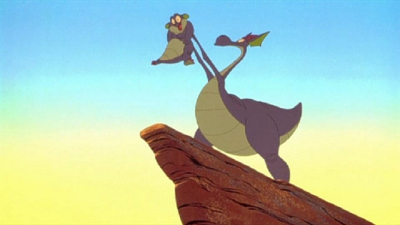
Is This Thing Loaded?
Apart from the isolated musical score, there are only a few other extras on this “Special Edition” Quest For Camelot disc. The main menus are nicely designed in keeping with the Medieval theme of the movie and feature selected quotes from Devon and Cornwall. These are, at first, fun, but become annoying after a while, especially every time you make a menu selection!
This being an early Warner release, it’s a flipper, with the special features on Side B. Rather than creating specific menus for each side, the disc uses the same on both, so many of the choices lead to “please flip the disc” screens, depending on what side you’re playing. When you do get to the extras, there’s a slim but interesting bunch to be found.
First up is the Forbidden Forest, a selection of video clips. Dragon Country takes you behind-the-scenes of Devon and Cornwall’s If I Didn’t Have You, offering an almost 4-minute “how it’s done” segment, as well as the song in work-in-progress pencil test stage (3.10). Heading over to Kayley’s House, you’ll find the Steve Perry music promo for I Stand Alone (3.40), which is your basic movie tie-in video clip. In Ruber’s Magic Well, there’s a featurette on the voice cast of Quest For Camelot. Running 3.45, it’s a nice look at what the actors really look like and how they approached their characters.
The Ogre’s Lair presents the three stages of computer animation that the animators went through to create the Rock Ogre in the film. These tests run a total of around 30 seconds, and there’s a huge jump between stages two and three. It would have been interesting to see all the various stages before the final composite, even if the CG ogre isn’t as subtle as Disney’s Deep Canvas technique developed and used for the three-dimensional tree vines of Tarzan’s jungle.
The Animation Process is a brief text article on the computer animation process and the goals that the crew set out to achieve, while the Warner Bros. Animation Legacy is a three-paragraph text that really says nothing new about the Studio. Also included is the film’s thrill-packed original theatrical trailer, which predictably features all the best moments and cuts so quickly that you can’t really tell what the state of the animation is like. Presented here in full-frame, it certainly helped to get me into the theater on the movie’s release, and still does a good job of making the film look great!
Lastly, there’s Warner’s Reel Recommendations of films that might be enjoyed if you liked this title. It’s a very mixed selection, and doesn’t seem to worry if the titles would appeal – or are even aimed at – children, with family friendly picks such as Free Willy, The Nutcracker, A Little Princess, The Secret Garden, Space Jam, Wild America and Willy Wonka supplemented by the rather adult 1960s musical bore Camelot and the extremely adult drama Excalibur, though there’s nothing in these previews that will offend.
As for any DVD-ROM additions, well, it’s clear that it’s not only Excalibur that’s been lost – there is no interactive PC content or any weblinks.
Case Study:
Released back in the days before WB ditched the “snap case” (which they continued to use due to their having a stake in the company!) and thus Quest For Camelot comes housed in such a box. The artwork, as usual for WB, follows along the lines of the original theatrical art, which again fails to prominently display the Excalibur sword adequately (it’s been thrown on the floor in this version). The inside fold-out contains the chapter index.
Ink And Paint:
Transferred from film, the image here is presented in its close to theatrical ratio of 1.78:1 and enhanced for anamorphic widescreen, not that you’d know from the packaging. The print used is clean, with a good contrast ratio and little artefacting on display, but there are a few pops and more gateweave than there should be for a film that made its DVD debut just five months after its theatrical release. Even though it’s an early release (so early in fact that it also made the rounds on LaserDisc), colors are strong and lively, with no bleed even on the most aggressive reds.
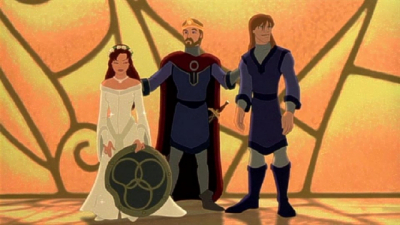
Scratch Tracks:
Presented in Dolby 5.1, the sound isn’t a reference demo track by any means. It does get excited in the flashier scenes, but overall is pretty much locked to the front left, center and right speakers. Dialogue is cleanly recorded and reproduced, with the songs blending in nicely and not louder than the standard acting voice levels. A French track is also available, and the dub is true to the original mix. An extra feature is the chance to listen to Patrick Doyle’s score on an isolated music track. One of the best things about the movie, the score is a full and rich orchestral experience, and Doyle uses the main motifs from the songs in the music, apart from the inclusion of a mysterious Irish-sounding theme that runs throughout the film. This isolated track extends to the songs, so you can hear the arrangements in the backing tracks sans vocals, or even sing along! Subtitles are provided in English and French.
Final Cut:
Like movie, like disc, the DVD version of Quest For Camelot falls a little short. The intentions are there but, like the film, it just needed a little more put into it. The added material could have been much more in depth, and instead of snippets of information contained in a couple of mini-length “documentaries”, perhaps a fully blown “making of” could have been included? The early pencil animation and computer animation tests are interesting to see, but again would have been more worthwhile given a commentary or an introduction to place them in proper context. Okay, it’s an early DVD release and at least it contains a little more than the movie and a trailer, but with the supplemental video clips adding up to just over 14 minutes and two very pointless text features, it’s hardly the Special Edition promised on the front cover. On the other hand, given its reception in theaters, credit must go to Warners for not letting this one just sink away completely. Quest For Camelot isn’t a bad film entirely; it’s mildly diverting and more than watchable, but one just gets the feeling that there was so much more lying beneath the surface!
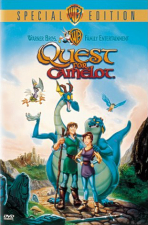 | ||
 |






